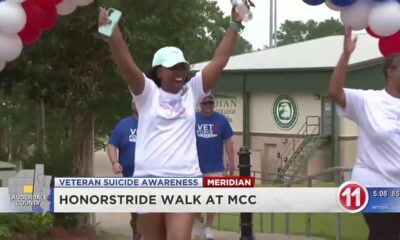Kaiser Health News
When Older Parents Resist Help or Advice, Use These Tips to Cope
by Judith Graham
Fri, 19 May 2023 09:00:00 +0000
It was a regrettable mistake. But Kim Sylvester thought she was doing the right thing at the time.
Her 80-year-old mother, Harriet Burkel, had fallen at her home in Raleigh, North Carolina, fractured her pelvis, and gone to a rehabilitation center to recover. It was only days after the death of Burkel's 82-year-old husband, who'd moved into a memory care facility three years before.
With growing distress, Sylvester had watched her mother, who had emphysema and peripheral artery disease, become increasingly frail and isolated. “I would say, ‘Can I help you?' And my mother would say, ‘No, I can do this myself. I don't need anything. I can handle it,'” Sylvester told me.
Now, Sylvester had a chance to get some more information. She let herself into her mother's home and went through all the paperwork she could find. “It was a shambles — completely disorganized, bills everywhere,” she said. “It was clear things were out of control.”
Sylvester sprang into action, terminating her mother's orders for anti-aging supplements, canceling two car warranty insurance policies (Burkel wasn't driving at that point), ending a yearlong contract for knee injections with a chiropractor, and throwing out donation requests from dozens of organizations. When her mother found out, she was furious.
“I was trying to save my mother, but I became someone she couldn't trust — the enemy. I really messed up,” Sylvester said.
Dealing with an older parent who stubbornly resists offers of help isn't easy. But the solution isn't to make an older person feel like you're steamrolling them and taking over their affairs. What's needed instead are respect, empathy, and appreciation of the older person's autonomy.
“It's hard when you see an older person making poor choices and decisions. But if that person is cognitively intact, you can't force them to do what you think they should do,” said Anne Sansevero, president of the board of directors of the Aging Life Care Association, a national organization of care managers who work with older adults and their families. “They have a right to make choices for themselves.”
That doesn't mean adult children concerned about an older parent should step aside or agree to everything the parent proposes. Rather, a different set of skills is needed.
Cheryl Woodson, an author and retired physician based in the Chicago area, learned this firsthand when her mother — whom Woodson described as a “very powerful” woman — developed mild cognitive impairment. She started getting lost while driving and would buy things she didn't need then give them away.
Chastising her mother wasn't going to work. “You can't push people like my mother or try to take control,” Woodson told me. “You don't tell them, ‘No, you're wrong,' because they changed your diapers and they'll always be your mom.”
Instead, Woodson learned to appeal to her mother's pride in being the family matriarch. “Whenever she got upset, I'd ask her, ‘Mother, what year was it that Aunt Terri got married?' or ‘Mother, I don't remember how to make macaroni. How much cheese do you put in?' And she'd forget what she was worked up about and we'd just go on from there.”
Woodson, author of “To Survive Caregiving: A Daughter's Experience, a Doctor's Advice,” also learned to apply a “does it really matter to safety or health?” standard to her mother's behavior. It helped Woodson let go of her sometimes unreasonable expectations. One example she related: “My mother used to shake hot sauce on pancakes. It would drive my brother nuts, but she was eating, and that was good.”
“You don't want to rub their nose into their incapacity,” said Woodson, whose mother died in 2003.
Barry Jacobs, a clinical psychologist and family therapist, sounded similar themes in describing a psychiatrist in his late 70s who didn't like to bend to authority. After his wife died, the older man stopped shaving and changing his clothes regularly. Though he had diabetes, he didn't want to see a physician and instead prescribed medicine for himself. Even after several strokes compromised his vision, he insisted on driving.
Jacobs' take: “You don't want to go toe-to-toe with someone like this, because you will lose. They're almost daring you to tell them what to do so they can show you they won't follow your advice.”
What's the alternative? “I would employ empathy and appeal to this person's pride as a basis for handling adversity or change,” Jacobs said. “I might say something along the lines of, ‘I know you don't want to stop driving and that this will be very painful for you. But I know you have faced difficult, painful changes before and you'll find your way through this.'”
“You're appealing to their ideal self rather than treating them as if they don't have the right to make their own decisions anymore,” he explained. In the older psychiatrist's case, conflict with his four children was constant, but he eventually stopped driving.
Another strategy that can be useful: “Show up, but do it in a way that's face-saving,” Jacobs said. Instead of asking your father if you can check in on him, “Go to his house and say, ‘The kids really wanted to see you. I hope you don't mind.' Or, ‘We made too much food. I hope you don't mind my bringing it over.' Or, ‘I wanted to stop by. I hope you can give me some advice about this issue that's on my mind.'”
This psychiatrist didn't have any cognitive problems, though he wasn't as sharp as he used to be. But encroaching cognitive impairment often colors difficult family interactions.
If you think this might be a factor with your parent, instead of trying to persuade them to accept more help at home, try to get them medically evaluated, said Leslie Kernisan, author of “When Your Aging Parent Needs Help: A Geriatrician's Step-by-Step Guide to Memory Loss, Resistance, Safety Worries, and More.”
“Decreased brain function can affect an older adult's insight and judgment and ability to understand the risks of certain actions or situations, while also making people suspicious and defensive,” she noted.
This doesn't mean you should give up on talking to an older parent with mild cognitive impairment or early-stage dementia, however. “You always want to give the older adult a chance to weigh in and talk about what's important to them and their feelings and concerns,” Kernisan said.
“If you frame your suggestions as a way of helping your parent achieve a goal they've said was important, they tend to be much more receptive to it,” she said.
A turning point for Sylvester and her mother came when the older woman, who developed dementia, went to a nursing home at the end of 2021. Her mother, who at first didn't realize the move was permanent, was furious, and Sylvester waited two months before visiting. When she finally walked into Burkel's room, bearing a Valentine's Day wreath, Burkel hugged her and said, “I'm so glad to see you,” before pulling away. “But I'm so mad at my other daughter.”
Sylvester, who doesn't have a sister, responded, “I know, Mom. She meant well, but she didn't handle things properly.” She learned the value of what she calls a “therapeutic fiblet” from Kernisan, who ran a family caregiver group Sylvester attended between 2019 and 2021.
After that visit, Sylvester saw her mother often, and all was well between the two women up until Burkel's death. “If something was upsetting my mother, I would just go, ‘Interesting,' or, ‘That's a thought.' You have to give yourself time to remember this is not the person you used to know and create the person you need to be your parent, who's changed so much.”
We're eager to hear from readers about questions you'd like answered, problems you've been having with your care, and advice you need in dealing with the health care system. Visit kffhealthnews.org/columnists to submit your requests or tips.
KFF Health News is a national newsroom that produces in-depth journalism about health issues and is one of the core operating programs at KFF—an independent source of health policy research, polling, and journalism. Learn more about KFF.
USE OUR CONTENT
This story can be republished for free (details).
By: Judith Graham
Title: When Older Parents Resist Help or Advice, Use These Tips to Cope
Sourced From: kffhealthnews.org/news/article/resistant-older-parents-empathy-pride/
Published Date: Fri, 19 May 2023 09:00:00 +0000
Did you miss our previous article…
https://www.biloxinewsevents.com/the-abortion-pill-goes-back-to-court/
Kaiser Health News
Medical Providers Still Grappling With UnitedHealth Cyberattack: ‘More Devastating Than Covid’
Samantha Liss
Fri, 19 Apr 2024 16:45:00 +0000
Two months after a cyberattack on a UnitedHealth Group subsidiary halted payments to some doctors, medical providers say they're still grappling with the fallout, even though UnitedHealth told shareholders on Tuesday that business is largely back to normal.
“We are still desperately struggling,” said Emily Benson, a therapist in Edina, Minnesota, who runs her own practice, Beginnings & Beyond. “This was way more devastating than covid ever was.”
Change Healthcare, a business unit of the Minnesota-based insurance giant UnitedHealth Group, controls a digital network so vast it processes nearly 1 in 3 U.S. patient records each year. The network is a critical conduit for shuttling information between most of the nation's insurance companies and medical providers, who submit claims through it to get paid for treating patients.
For Benson, the cyberattack continues to significantly disrupt her business and her ability to pay her seven other clinicians.
Before the hack brought down the system, an insurance company would process a provider's claim, then send a type of receipt known as an “electronic remittance,” which details the amount the provider was paid and whether the claim was denied. Without it, providers don't know if they were paid correctly or how much to bill patients.
Now, instead of automatically handling those receipts digitally, some insurers must send forms in the mail. The forms require manual entry, which Benson said is a time-consuming process because it requires her to match up service dates and details to divvy up pay among her clinicians. And from at least one insurer, she said, she has yet to receive any remittances.
“I'm holding on to my sanity by a thread,” Benson said.
The situation is so dire, Alex Shteynshlyuger, a urologist who owns a practice in New York City, said he had to transfer money from his personal accounts to pay his office bills.
“Look, I am freaking out,” Shteynshlyuger said. “Everyone is freaking out. We are like monkeys in a cage. We can't really do anything about it.”
Roughly 30% of his claims were routed through Change's platform. Except for Medicare and certain Blue Cross plans, he said, he has been unable to submit claims or receive payment from any insurers.
The company is encouraging struggling providers to reach out to the company directly via its website, said Tyler Mason, vice president of communications for UnitedHealth Group.
“I don't think we've had a single provider that hasn't been helped that's contacted us.” As part of that help, Mason said, UnitedHealth has sent providers $7 billion so far.
Ever since the February cyberattack forced UnitedHealth to disconnect its Change platform, the company has been working “day and night to restore services” and has made “substantial progress,” UnitedHealth CEO Andrew Witty told shareholders April 16.
“We see a fairly normal claims receipts and payments flow going on at this point,” Chief Financial Officer John Rex said during the shareholder call. “But we'll really want to be careful on that because we know there are certain care providers out there that may have been left out of it.”
Rex said the company expects full operations to resume next year.
The company reported that the hacking has already cost it $870 million and that leaders expect the final tally to total at least $1 billion this year. To put that in perspective, the company reported $99.8 billion in revenue for the first quarter of 2024, an 8.6% increase over that period last year.
Meanwhile, the House Energy and Commerce Health Subcommittee held a hearing April 16 seeking answers on the severity and damage the cyberattack caused to the nation's health system.
Subcommittee chair Brett Guthrie (R-Ky.) said a provider in his hometown is still grappling with the fallout from the attack and losing staff because they can't make payroll. Providers “still haven't been made whole,” Guthrie said.
Rep. Frank Pallone Jr. (D-N.J.) voiced concern that a “single point of failure” reverberated around the country, disrupting patients' access and providers' financial stability.
Lawmakers expressed frustration that UnitedHealth failed to send a representative to the Capitol to answer their questions. The committee had sent Witty a list of detailed questions ahead of the hearing but was still awaiting answers.
As providers wait, too, they are trying to cover the gaps. To pay her practice's bills, Benson said, she had to take out a nearly $40,000 loan — from a division of UnitedHealth.
——————————
By: Samantha Liss
Title: Medical Providers Still Grappling With UnitedHealth Cyberattack: ‘More Devastating Than Covid'
Sourced From: kffhealthnews.org/news/article/cyberattack-fallout-unitedhealth-change-healthcare-medical-providers-financial-instability/
Published Date: Fri, 19 Apr 2024 16:45:00 +0000
Kaiser Health News
He Thinks His Wife Died in an Understaffed Hospital. Now He’s Trying to Change the Industry.
Kate Wells, Michigan Public
Fri, 19 Apr 2024 09:00:00 +0000
For the past year, police Detective Tim Lillard has spent most of his waking hours unofficially investigating his wife's death.
The question has never been exactly how Ann Picha-Lillard died on Nov. 19, 2022: She succumbed to respiratory failure after an infection put too much strain on her weakened lungs. She was 65.
For Tim Lillard, the question has been why.
Lillard had been in the hospital with his wife every day for a month. Nurses in the intensive care unit had told him they were short-staffed, and were constantly rushing from one patient to the next.
Lillard tried to pitch in where he could: brushing Ann's shoulder-length blonde hair or flagging down help when her tracheostomy tube gurgled — a sign of possible respiratory distress.
So the day he walked into the ICU and saw staff members huddled in Ann's room, he knew it was serious. He called the couple's adult children: “It's Mom,” he told them. “Come now.”
All he could do then was sit on Ann's bed and hold her hand, watching as staff members performed chest compressions, desperately trying to save her life.
A minute ticked by. Then another. Lillard's not sure how long the CPR continued — long enough for the couple's son to arrive and take a seat on the other side of Ann's bed, holding her other hand.
Finally, the intensive care doctor called it and the team stopped CPR. Time of death: 12:37 p.m.
Lillard didn't know what to do in a world without Ann. They had been married almost 25 years. “We were best friends,” he said.
Just days before her death, nurses had told Lillard that Ann could be discharged to a rehabilitation center as soon as the end of the week. Then, suddenly, she was gone. Lillard didn't understand what had happened.
Lillard said he now believes that overwhelmed, understaffed nurses hadn't been able to respond in time as Ann's condition deteriorated. And he has made it his mission to fight for change, joining some nursing unions in a push for mandatory ratios that would limit the number of patients in a nurse's care. “I without a doubt believe 100% Ann would still be here today if they had staffing levels, mandatory staffing levels, especially in ICU,” Lillard said.
Last year, Oregon became the second state after California to pass hospital-wide nurse ratios that limit the number of patients in a nurse's care. Michigan, Maine, and Pennsylvania are now weighing similar legislation.
But supporters of mandatory ratios are going up against a powerful hospital industry spending millions of dollars to kill those efforts. And hospitals and health systems say any staffing ratio regulations, however well-intentioned, would only put patients in greater danger.
Putting Patients at Risk
By next year, the United States could have as many as 450,000 fewer nurses than it needs, according to one estimate. The hospital industry blames covid-19 burnout, an aging workforce, a large patient population, and an insufficient pipeline of new nurses entering the field.
But nursing unions say that's not the full story. There are now 4.7 million registered nurses in the country, more than ever before, with an estimated 130,000 nurses having entered the field from 2020 to 2022.
The problem, the unions say, is a hospital industry that's been intentionally understaffing their units for years in order to cut costs and bolster profits. The unions say there isn't a shortage of nurses but a shortage of nurses willing to work in those conditions.
The nurse staffing crisis is now affecting patient care. The number of Michigan nurses who say they know of a patient who has died because of understaffing has nearly doubled in recent years, according to a Michigan Nurses Association survey last year.
Just months before Ann Picha-Lillard's death, nurses and doctors at the health system where she died had asked the Michigan attorney general to investigate staffing cuts they believed were leading to dangerous conditions, including patient deaths, according to The Detroit News.
But Lillard didn't know any of that when he drove his wife to the hospital in October 2022. She had been feeling short of breath for a few weeks after she and Lillard had mild covid infections. They were both vaccinated, but Ann was immunocompromised. She suffered from rheumatoid arthritis, a condition that had also caused scarring in her lungs.
To be safe, doctors at DMC Huron Valley-Sinai Hospital wanted to keep Ann for observation. After a few days in the facility, she developed pneumonia. Doctors told the couple that Ann needed to be intubated. Ann was terrified but Lillard begged her to listen to the doctors. Tearfully, she agreed.
With Ann on a ventilator in the ICU, it seemed clear to Lillard that nurses were understaffed and overwhelmed. One nurse told him they had been especially short-staffed lately, Lillard said.
“The alarms would go off for the medications, they'd come into the room, shut off the alarm when they get low, run to the medication room, come back, set them down, go to the next room, shut off alarms,” Lillard recalled. “And that was going on all the time.”
Lillard felt bad for the nurses, he said. “But obviously, also for my wife. That's why I tried doing as much as I could when I was there. I would comb her hair, clean her, just keep an eye on things. But I had no idea what was really going on.”
Finally, Ann's health seemed to be stabilizing. A nurse told Lillard they'd be able to discharge Ann, possibly by the end of that week.
By Nov. 17, Ann was no longer sedated and she cried when she saw Lillard and her daughter. Still unable to speak, she tried to mouth words to her husband “but we couldn't understand what she was saying,” Lillard said.
The next day, Lillard went home feeling hopeful, counting down the days until Ann could leave the hospital.
Less than 24 hours later, Ann died.
Lillard couldn't wrap his head around how things went downhill so fast. Ann's underlying lung condition, the infection, and her weakened state could have proved fatal in the best of circumstances. But Lillard wanted to understand how Ann had gone from nearly discharged to dying, seemingly overnight.
He turned his dining room table into a makeshift office and started with what he knew. The day Ann died, he remembered her medical team telling him that her heart rate had spiked and she had developed another infection the night before. Lillard said he interviewed two DMC Huron Valley-Sinai nurse administrators, and had his own doctor look through Ann's charts and test results from the hospital. “Everybody kept telling me: sepsis, sepsis, sepsis,” he said.
Sepsis is when an infection triggers an extreme reaction in the body that can cause rapid organ failure. It's one of the leading causes of death in U.S. hospitals. Some experts say up to 80% of sepsis deaths are preventable, while others say the percentage is far lower.
Lives can be saved when sepsis is caught and treated fast, which requires careful attention to small changes in vital signs. One study found that for every additional patient a nurse had to care for, the mortality rate from sepsis increased by 12%.
Lillard became convinced that had there been more nurses working in the ICU, someone could have caught what was happening to Ann.
“They just didn't have the time,” he said.
DMC Huron Valley-Sinai's director of communications and media relations, Brian Taylor, declined a request for comment about the 2022 staffing complaint to the Michigan attorney general.
Following the Money
When Lillard asked the hospital for copies of Ann's medical records, DMC Huron Valley-Sinai told him he'd have to request them from its parent company in Texas.
Like so many hospitals in recent years, the Lillards' local health system had been absorbed by a series of other corporations. In 2011, the Detroit Medical Center health system was bought for $1.5 billion by Vanguard Health Systems, which was backed by the private equity company Blackstone Group.
Two years after that, in 2013, Vanguard itself was acquired by Tenet Healthcare, a for-profit company based in Dallas that, according to its website, operates 480 ambulatory surgery centers and surgical hospitals, 52 hospitals, and approximately 160 additional outpatient centers.
As health care executives face increasing pressure from investors, nursing unions say hospitals have been intentionally understaffing nurses to reduce labor costs and increase revenue. Also, insurance reimbursements incentivize keeping nurse staffing levels low. “Hospitals are not directly reimbursed for nursing services in the same way that a physician bills for their services,” said Karen Lasater, an associate professor of nursing in the Center for Health Outcomes and Policy Research at the University of Pennsylvania. “And because hospitals don't perceive nursing as a service line, but rather a cost center, they think about nursing as: How can we reduce this to the lowest denominator possible?” she said.
Lasater is a proponent of mandatory nurse ratios. “The nursing shortage is not a pipeline problem, but a leaky bucket problem,” she said. “And the solutions to this crisis need to address the root cause of the issue, which is why nurses are saying they're leaving employment. And it's rooted in unsafe staffing. It's not safe for the patients, but it's also not safe for nurses.”
A Battle Between Hospitals and Unions
In November, almost one year after Ann's death, Lillard told a room of lawmakers at the Michigan State Capitol that he believes the Safe Patient Care Act could save lives. The health policy committee in the Michigan House was holding a hearing on the proposed act, which would limit the amount of mandatory overtime a nurse can be forced to work, and require hospitals to make their staffing levels available to the public.
Most significantly, the bills would require hospitals to have mandatory, minimum nurse-to-patient ratios. For example: one nurse for every patient in the ICU; one for every three patients in the emergency room; a nurse for triage; and one nurse for every four postpartum birthing patients and well-baby care.
Efforts to pass mandatory ratio laws failed in Washington and Minnesota last year after facing opposition from the hospital industry. In Minnesota, the Minnesota Nurses Association accused the Mayo Clinic of using “blackmail tactics”: Mayo had told lawmakers it would pull billions of dollars in investment from the state if mandatory ratio legislation passed. Soon afterward, lawmakers removed nurse ratios from the legislation.
While Lillard waited for his turn to speak to Michigan lawmakers about the Safe Patient Care Act in November, members of the Michigan Nurses Association, which says it represents some 13,000 nurses, told lawmakers that its units were dangerously understaffed. They said critical care nurses were sometimes caring for up to 11 patients at a time.
“Last year I coded someone in an ICU for 10 minutes, all alone, because there was no one to help me,” said the nurses association president and registered nurse Jamie Brown, reading from another nurse's letter.
“I have been left as the only specially trained nurse to take care of eight babies on the unit: eight fragile newborns,” said Carolyn Clemens, a registered nurse from the Grand Blanc area of Michigan.
Nikia Parker said she has left full-time emergency room nursing, a job she believes is her calling. After her friend died in the hospital where she worked, she was left wondering whether understaffing may have contributed to his death.
“If the Safe Patient Care Act passed, and we have ratios, I'm one of those nurses who would return to the bedside full time,” Parker told lawmakers. “And so many of my co-workers who have left would join me.”
But not all nurses agree that mandatory ratios are a good idea.
While the American Nurses Association supports enforceable ratios as an “essential approach,” that organization's Michigan chapter does not, saying there may not be enough nurses in the state to satisfy the requirements of the Safe Patient Care Act.
For some lawmakers, the risk of collateral damage seems too high. State Rep. Graham Filler said he worries that mandating ratios could backfire.
“We're going to severely hamper health care in the state of Michigan. I'm talking closed wards because you can't meet the ratio in a bill. The inability for a hospital to treat an emergent patient. So it feels kind of to me like a gamble we're taking,” said Filler, a Republican.
Michigan hospitals are already struggling to fill some 8,400 open positions, according to the Michigan Health & Hospital Association. That association says that complying with the Safe Patient Care Act would require hiring 13,000 nurses.
Every major health system in the state signed a letter opposing mandatory ratios, saying it would force them to close as many as 5,100 beds.
Lillard watched the debate play out in the hearing. “That's a scare tactic, in my opinion, where the hospitals say we're going to have to start closing stuff down,” he said.
He doesn't think legislation on mandatory ratios — which are still awaiting a vote in the Michigan House's health policy committee — are a “magic bullet” for such a complex, national problem. But he believes they could help.
“The only way these hospitals and the administrations are gonna make any changes, and even start moving towards making it better, is if they're forced to,” Lillard said.
Seated in the center of the hearing room in Lansing, next to a framed photo of Ann, Lillard's hands shook as he recounted those final minutes in the ICU.
“Please take action so that no other person or other family endures this loss,” he said. “You can make a difference in saving lives.”
Grief is one thing, Lillard said, but it's another thing to be haunted by doubts, to worry that your loved one's care was compromised before they ever walked through the hospital doors. What he wants most, he said, is to prevent any other family from having to wonder, “What if?”
This article is from a partnership that includes Michigan Public, NPR, and KFF Health News.
——————————
By: Kate Wells, Michigan Public
Title: He Thinks His Wife Died in an Understaffed Hospital. Now He's Trying to Change the Industry.
Sourced From: kffhealthnews.org/news/article/nurse-ratios-understaffed-hospitals-michigan-legislation-detective-wife/
Published Date: Fri, 19 Apr 2024 09:00:00 +0000
Kaiser Health News
In San Francisco’s Chinatown, a CEO Works With the Community To Bolster Hospital
Bernard J. Wolfson
Fri, 19 Apr 2024 09:00:00 +0000
SAN FRANCISCO — Chinese Hospital, located in the heart of this city's legendary Chinatown, struggles with many of the same financial and demographic challenges that plague small independent hospitals in underserved areas across the country.
Many of its patients are aging Chinese speakers with limited incomes who are reliant on Medicare and Medi-Cal, which pay less than commercial insurance and often don't fully cover provider costs. And due to an arcane federal rule, Chinese Hospital receives a lower rate of reimbursement than many other hospitals that treat a large number of low-income patients. Add the high cost of labor and supplies in this post-pandemic world, and it's not hard to see why the hospital lost $20 million over the past two years and tapped a nearly $10.4 million loan from the state's distressed hospital loan fund.
Yet the 88-bed hospital has strong ties to the University of California-San Francisco and the city's public health department. And it gets support from businesses, charities, and the surrounding community. For Jian Zhang, 58, the hospital's CEO since 2017, fundraising is like breathing.
“I feel like it's a full-time job for me,” said Zhang, who arrived in San Francisco from Guangzhou, China, as an international student in 1990, earned a nursing doctorate from the University of San Francisco, and has remained in the Bay Area.
Revenue from fundraising and other services have provided a big boost, helping the hospital significantly offset what it lost on patient care in 2022, according to the hospital and state data. By contrast, Madera Community Hospital and Beverly Hospital were far less able to do so. Those hospitals, which also serve low-income populations with many patients on government health care programs, filed for bankruptcy last year.
Chinese Hospital has its roots in a medicinal dispensary, founded in 1899 to provide health care for Chinese immigrants who were effectively excluded from mainstream medical facilities. The hospital itself opened in 1925, and a second building was added next door in 1979. In 2016, a new building replaced the original hospital.
Today, Chinese Hospital includes those two buildings plus five outpatient clinics offering Eastern and Western medicine, spread out across San Francisco and neighboring San Mateo County. Through partnerships, Chinese Hospital has been able to offer specialty services to its patients, including eye surgery, palliative care, and a stroke center. And $10 million in grants it received from the state last year will help build a subacute unit, which is for fragile patients who still need nursing and monitoring following a hospital stay.
In an interview with KFF Health News senior correspondent Bernard J. Wolfson, Zhang discussed the challenges facing small independent hospitals, including Chinese Hospital, and offered her vision for its future. The following Q&A has been edited for length and clarity:
Q: What are some of the main challenges your hospital faces?
We are facing all the challenges other hospitals are facing, especially the covid pandemic and its associated negative impact — the physician shortage and workforce shortage, the labor cost increases. But as a small community hospital, we don't have a lot of reserve money. It's hard to make ends meet.
That is a huge challenge because of the low reimbursement rate. We serve more than 80% Medicare and Medi-Cal patients.
Q: What are some specific challenges of serving a largely Chinese population?
In this market, with the workforce shortage, and especially after the pandemic, it's even harder to recruit bilingual physicians, and other bilingual staff.
And culturally, Chinese patients, when they are sick, need to drink soup for healing or eat certain other foods for healing. You can't be providing sandwiches and salads. They won't eat that. So our kitchen has to provide Chinese food, has to boil soup, and then we have to cook different food for our patients who are non-Chinese.
Q: Are you concerned about the state's budget shortfall?
Absolutely. We all were expecting that Medi-Cal would increase rates. We have been pushing that for many years. But if it's not going to happen, a lot of our programs we probably won't be able to do. I am very concerned about it.
Q: Chinese Hospital has its own health plan, and you said 40% to 50% of your patients are members of it. How has that helped?
It's like Kaiser Permanente. You have your own members, and you manage them. You want your patients to be in outpatient. So you take care of them, keep them healthy, so they don't need to come to the hospital for acute care. That's how you save money.
Q: And I imagine that getting fixed monthly payments — capitation payments — for a large proportion of your patients also helps?
Definitely, capitation payments help. Especially during the pandemic. Think about it. If you didn't have capitation payments, when procedures were canceled, you didn't have income.
Q: What else has helped you weather the storm?
We have partnerships with San Francisco's Department of Public Health and UCSF. During the pandemic, we took overflow patients from the city, so we didn't have to lay off a lot of people. We signed a contract with the city to open up the second floor of our hospital to take overflow patients from Zuckerberg San Francisco General hospital.
Q: You also have strong fundraising activity.
We do have strong community support. The hospital is not just a hospital to me. It's really part of our history. In the past, it was the only place [Chinese people] could go. Wherever I went, to a conference, for example, somebody would raise their hand and say, “Oh, I was born at Chinese Hospital” or “My grandfather was born at Chinese Hospital.” It is really, really deeply rooted in the community.
Q: What's your vision for the future of the hospital?
Chinese Hospital is very important to the community, and I want to see it survive and thrive. But it definitely needs support from the government and from the community. Moving forward, we will continue to build on collaborations and partnerships.
This article was produced by KFF Health News, which publishes California Healthline, an editorially independent service of the California Health Care Foundation.
——————————
By: Bernard J. Wolfson
Title: In San Francisco's Chinatown, a CEO Works With the Community To Bolster Hospital
Sourced From: kffhealthnews.org/news/article/san-francisco-chinatown-chinese-hospital-ceo-jian-zhang-interview/
Published Date: Fri, 19 Apr 2024 09:00:00 +0000
Did you miss our previous article…
https://www.biloxinewsevents.com/newsom-offers-a-compromise-to-protect-indoor-workers-from-heat/
-
Mississippi News6 days ago
Mississippi will soon be bombarded with cicadas
-
SuperTalk FM5 days ago
4 tornadoes touched down in Mississippi during latest round of severe storms
-
SuperTalk FM3 days ago
Chance of parole denied for man who killed 3 Choctaw Indian tribal members
-
SuperTalk FM6 days ago
2 Jones County correctional officers arrested in smuggling bust
-
Local News6 days ago
Almost 3,500 Mississippi Veterans have enrolled in VA health care in past 365 days, 28% increase over last year
-
Kaiser Health News3 days ago
To Stop Fentanyl Deaths in Philadelphia, Knocking on Doors and Handing Out Overdose Kits
-
SuperTalk FM5 days ago
Amazon project in Madison County to be over $10B, create more jobs than projected: report
-
SuperTalk FM2 days ago
2 arrested after missing man’s body found on side of Mississippi highway

































